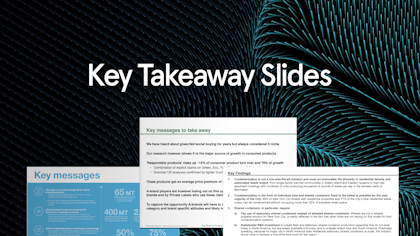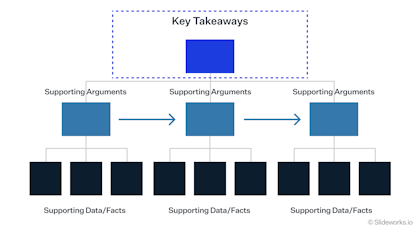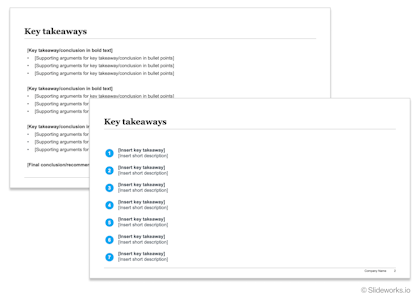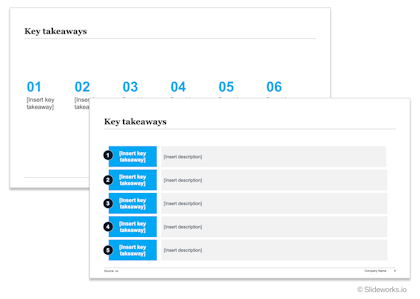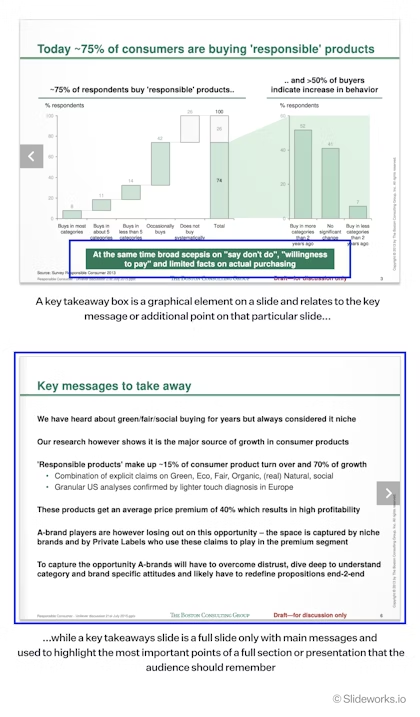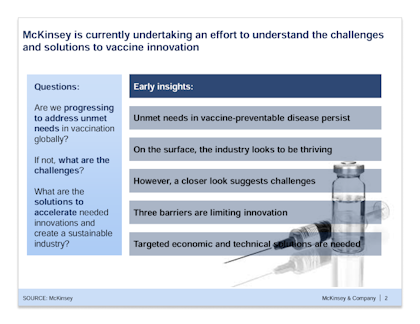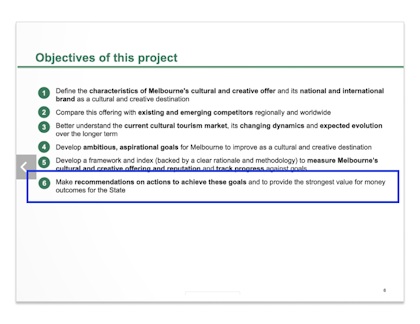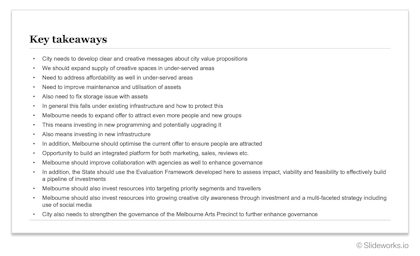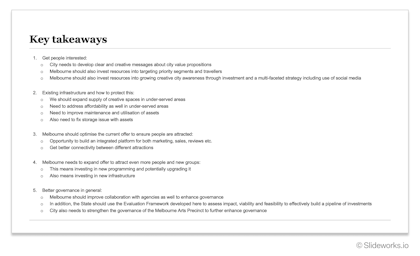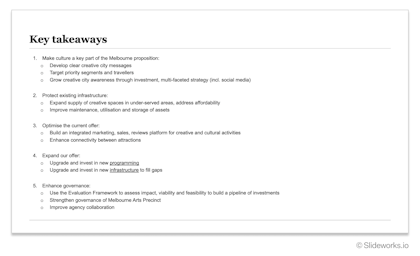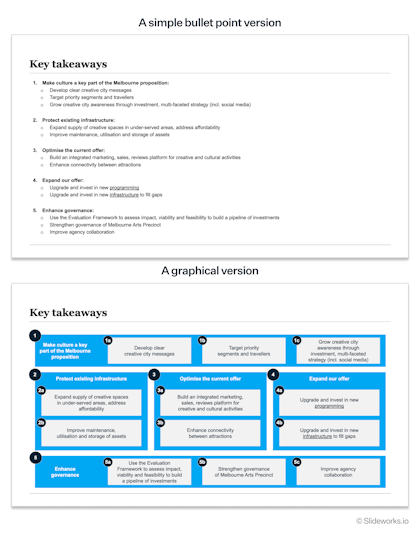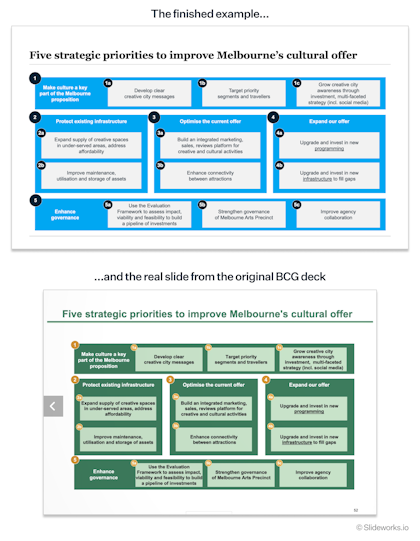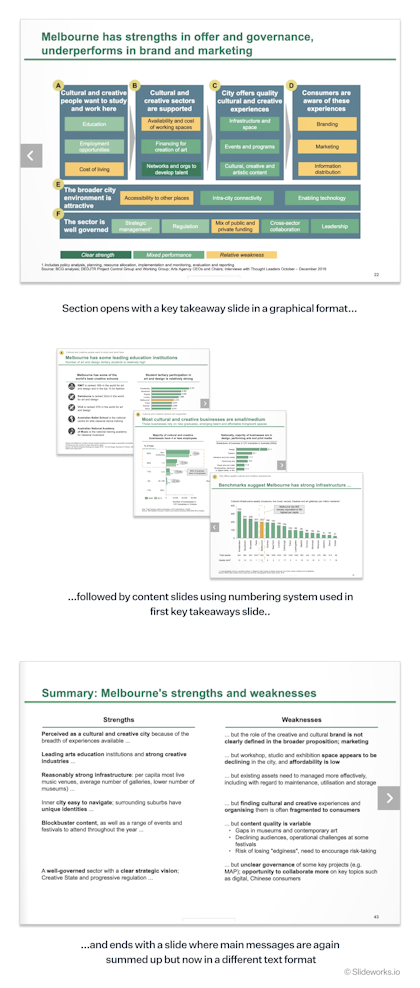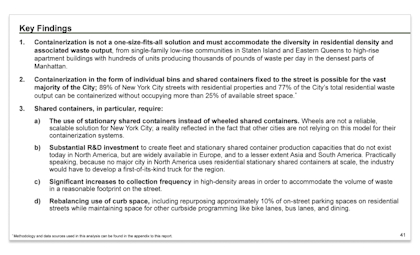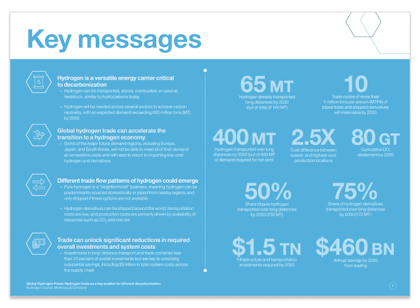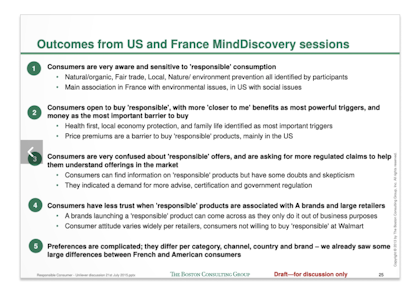BCG, Bain, and McKinsey consultants love the term “key takeaways”. When it comes to consulting presentations, the term usually refers to one of two things:
- Key takeaway slides: A slide that summarizes the most important conclusions, insights, or action points covered in the presentation or section.
- Key takeaway boxes: A small rectangular box of text at the bottom of a slide, sometimes also called a ‘kicker box’.
In this short post, we will teach you about the key takeaway slide, how it is different from the key takeaway box, how to write a key takeaway slide, and give you examples from McKinsey and BCG presentations and a free template for you to create your own.
Let’s dive in.
What are key takeaways?
Key takeaways are the main points of a given project or presentation that you want the audience to walk away remembering. Key takeaways are not a play-by-play summary of every conclusion in the project or presentation, but rather the most important conclusions. Key takeaways of a project can therefore differ depending on who the audience is and what their objectives are.
Using key takeaways helps elevate your presentation from okay to truly impactful. It helps your audience to focus on what the presentation is about and allows them to read the detailed findings with the main conclusion in mind. This means they are less likely to get lost in insignificant facts and are more able to ask questions that have an impact on outcomes.
Key takeaways are the top of the pyramid when following the Pyramid Principle.
What is a key takeaway slide?
A key takeaway slide is very simply a slide summarizing the key takeaways of a full presentation or chapter/section within a presentation.
The key takeaway slide can be simple bullet points on a text slide like the example here:
Or the key takeaway slide can include more elaborate graphical elements like colored boxes, numbers, icons or similar like the example here:
How is a key takeaway slide different from a takeaway box?
The key takeaway slide is a summation of most important points from the entire presentation or section. It basically presents the answers to the questions that particular presentation or project was meant to uncover.
A key takeaway box in contrast is a graphical element used on single slides to highlight a point on that slide. The takeaways here are often more granular and relate only to the slide in question.
When to use a key takeaway slide?
Not surprisingly, you should use a key takeaway slide whenever you feel it makes sense to summarize key points for your readers. This is often at the beginning and/or end of a presentation, or at the beginning of a longer section of a slide deck.
Generally, you can never repeat key takeaways too often, which means you more often than not should include a key takeaways slide. As a rule of thumb you can always add a key takeaways slide before every major section of your presentation and then delete it at the end of your slide writing if it feels redundant. This will help you a) make sure you have thought through what your key points for that section are and b) that the slides in that section actually support your key points without excess or unnecessary material.
The key takeaways slide is in the family of summary slides with the executive summary and recommendation slides. This trio of slides can be used in combination, often with an executive summary in the beginning (summarizing the most important key takeaways and recommendations from the entire presentation), key takeaway slides before or after every major section, and recommendation slides at the end.
How to write a key takeaway slide?
Writing a key takeaway slide is somewhat similar to writing your executive summary slide.
Step 1: Start with the questions
Before you even begin writing your key takeaway slide then take a moment to remind yourself which questions your presentation or that section are meant to answer.
For example, BCG once had a project for the Victoria State Government on Melbourne as a global cultural destination (see the project here). The main question that the project and report was supposed to answer was how to improve Melbourne’s attractiveness as a cultural and creative destination.
The objective for a section of the report was to “Make recommendations on actions to achieve these goals and to provide the strongest value for money outcomes for the State”.
In the next steps, we’ll continue with that section and example.
Step 2: Outline the answers
Once you have the questions/objectives in mind, then write down answers to these questions. Don’t worry about conciseness or smart formulations right now, just get all answers down in text format on your slide. Also add sentences on any unexpected findings that could have major implications going forward.
Step 3: Group the answers
Now group your findings/takeaways into main bullet points. If there are takeaways that overlap somewhat, see if you can combine them or eliminate one (if it makes sense). The reason to group into bullet points is to make it clear to your reader what the main areas for objective x are.
Ideally, you should have between three and nine overall bullet points with sub-points in each if needed.
Step 4: Cut and trim the wording
Once you’ve grouped the takeaways, you want to start trimming words and restructuring sentences. Delete any additional words that you possibly can and structure the sentences in the shortest way that still gets the meaning across. Err on the side of more active sentences that tell the reader what to conclude or convey an actionable item.
You want your readers to be able to quickly grasp the key points and not get lost in a wall of text.
Step 5: Format the slide
Once you have the content of your key takeaways slide in place, you can start formatting it to make it even more digestible for your reader. You can either keep the simple bullet format or add graphical elements to make it more visually appealing and easy to interpret
Golden rule here: Simple is better. Only use different colors or add icons or numbers if these are used in the rest of the presentation to distinguish solution areas.
Step 6: Add an action title
Now you’re almost done with your key takeaways slide. The last missing piece is adding an action title. Although this is not an absolute must, an action title will help your readers understand what objective/questions these key takeaways relate to. Best practice is therefore to use that objective/question directly in the action title, like the example below.
Step 7: Sanity check with others
The final step of creating your key takeaways slide is to sanity check your key takeaways with your team and/or trusted advisors to see if they find them clear and give answers to the questions/objective.
Ideally, your reader can see only your key takeaway slide and from that still relay to others what the outcome of your project or section is.
Examples of key takeaway slides
To make it more useful and real, we’ve also found some examples of key takeaway slides from real McKinsey and BCG presentations.
First, we see a great example of how to use a key takeaway slide from BCG (find the full presentation here):
Here we see how the BCG team opens the section with a key takeaways slide in a graphical format that allows the reader to both understand the different levers and how the client is doing on each of these levers. The slide itself uses colors instead of sentences to convey a status.
The following slides in the section then reference back to this key takeaways slide using the letter-balls and lever headlines as guides.
Finally, the section ends with a key takeaways slide that says the same as the opening takeaway slide but in words instead of colors.
Second, we have an example of a simple text-based key takeaways slide from McKinsey (full presentation here), which summarizes the key takeaways for a section of a presentation:
Third, we have a more graphical example of a key takeaways slide from McKinsey using radically larger font sizes to appealingly display several key numbers (find the full presentation here). Note also how the McKinsey team has drawn attention to the main messages by using bold text. This is a classic trick and very effective.
Key takeaway slides are not only used in management consulting presentations. Below is a great example from an Uber investor presentation showing how use of simple icons and bold text help the reader focus on the messages.
Finally, we have a simple but effective example of a key takeaways slide from BCG using simple graphical elements like number balls and bold text to make the main messages stand out (see the full deck here).
Free key takeaway slide template
Get a jumpstart on creating your own key takeaway slides with our free PowerPoint template. Just fill in your information and get the template delivered to your email.
Free PowerPoint template for creating key takeaway slides:
Download now





